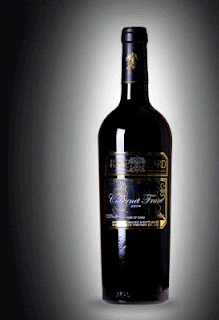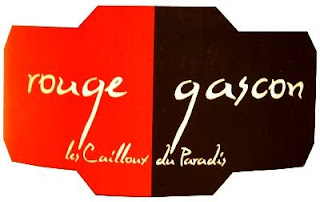It’s not a good idea to schedule appointments on the Friday after a Thursday Bank Holiday: too many people decide the weekend strts there. So given an unscheduled amount of liberty in Hamburg recently, we decided that music’s loss would be Slotovino’s gain.
After the usual faffing, we managed to find our way to Hanseaten Select, Oberhafenstrasse 1, 20097 Hamburg where we asked our usual question about ‘ungewöhnliche Rebsorten’ (
unusual grape varieties) and were met with the characteristic rabbit-caught-in-the-headlights look. It seems that the Germans are every bit as terroir-oriented as the French in these matters with the only difference being that they are able eventually to cotton on and enter into the process of solving the problem with enthusiasm.
Thus it was that Heiko Dornberger, otherwise our human SatNav in numerous telephone calls attempting to find Oberhafenstrasse was able to give us a grand tour of his stock producing a Schneider (Pfalz) Cuvee “Ursprung” (14%)

of Cabernet Sauvignon, Merlot and Potugieser, the first two of which are only recent additions to varieties grown in Germany and a bottle of our old friend Goldriesling from Schloss Proschwitz of Meissen (Germany’s most northerly vineyard)

which we have decided no cellar should be without.
However it was for Chinese wine that we had made our tedious way to Hanseaten Select since they seem to have pioneered its importation to Germany or practically anywhere else. Mr. Dornberger chided us for not having called ahead to check if he had what we were looking for in stock. This is becoming a bad habit of ours but we can excuse ourselves by pleading blind enthusiasm when we make a find such as Cabernet Gernischt online.
This last strangely-named and obscure grape was in the 19th century a permitted local grape variety in Bordeaux and the story has it that cuttings were sent to China in 1892 - the very early days of Western plantings there. The variety then disappeared in Bordeaux post Phylloxera leaving the Chinese plantings as the only ones in existence, a bit like Carmenère in Chile, although that grape never disappeared so thoroughly as Cabernet Gernischt did from Bordeaux it seems. The Gernischt seems to be a misspelling for
Gemischt although how a Bordeaux grape came by a German name is unclear. Cabernet Gemischt or Gernischt seems to be similar to Cabernet Franc, it is generally agreed.

It also seemed that the bottle of Chateau Changyu-Castel Cabernet Gernischt (Shandong) was at another address in Hansastadt Hamburg and would not be available until the following morning by which time we would have departed. Mr. Dornberger kindly offered to mail the bottle to us and discovering that we could have three bottles for the same price as one, we also bought a Chinese Tasya Cabernet Franc

and a Chairman’s Reserve

both from Grace Vineyards in Shanxi to be posted too. We are awaiting their arrival as we write.
An added bonus was the fact that Mr. Dornberger deducted 50% from the price, explaining that they didn’t do Chinese wine any more and he was trying to ditch his existing stock. His expression in saying this spoke of ‘difficulties’ in importing Chinese wines. He didn’t exactly laugh as we left the shop but he did help us exit our rather tight parking space. He was in fact an expert in South African wine and was remarkably charming and helpful in view of the fact he had been stranded for a week in South Africa by the dust cloud without any help at all from British Airways.
Next we thought we would give Castel Cosimo, a joint with customer parking around the corner a quick looking-over on our way to Lübeck. This turned out to be an unexpected treasure trove. Specialising in Italian wine, they at first seemed to have inordinate trouble in getting their minds around our usual question but once they had grasped the concept, the information came tumbling out and we discovered
Cesanese
Tai Rosso
Vernaccia Nera
A Forastera/Biancolella blend from Ischia
and an amazing Raboso del Piave (14%) with sugar at 44.3 which is apparently mega.
We have to compliment Castel Cosimo for giving the following information on their wines on their website: unprecedented in our experience. The following refers to the Raboso just mentioned:
Anbauregion: Veneto/Venetien, Provinz Treviso
Jahrgang: 2005
Erzeuger: Weingut Cà di Rajo, San Polo di Piave
Ausbau: großes Holz, neue Barriques (30%) - 36 Monate
Weinart: Rot
Geschmack: trocken, sehr kräftig, würzig
Traubensorten: Raboso (30% angetrocknet)
zulässiger
Hektarertrag (in kg): 10.000
tatsächlicher
Hektarertrag (in kg): 5.000 kg
Boden: lehmhaltige Sand- und Schotterböden
Haltbarkeit (in Jahren): 15
Trinktemperatur (in °C): 20
Restzucker (in g/l): 5.8
Alkohol (in %): 14,0
Extrakt (in g/l): 44,3
SO 2 frei (in mg/l): 24
SO 2 gesamt (in mg/l): 72
Säure gesamt (Weinsäure) (in g/l): 7,6
ph-Wert: 3,46
Passend zu: dunkl. Fleisch/Wild, gereift. Käse, Genußwein
Unlike the back label we saw in the Landside supermarket at Hannover Airport, most of this information is interesting and indeed necessary. It should be mandatory.
We later discovered they also stocked a white wine from Passerina grapes which are unknown to us. Next time.
In Lübeck our research took us to Carl Tesdorpf (founded by Peter Hinrich Tesdorpf

in 1678) in the Mengstrasse where Thomas Mann set the family house of the Buddenbrooks. This is the Berry Brothers and Rudd of Lübeck. The shop is in a beautiful Hanseatic Merchant’s Stadtpalais-cum- warehouse such as one finds in Amsterdam and Venice.

We quickly found our Elbling from Schloss Prozchwitz (see above),

a rarity even to the Germans. We had bought this before but drank it in ignorance of the grape’s antiquity and without too much memory of its character other than a generally aimeable nature.
Now the word ‘Rarität’ to the Germans means only rare vintages mostly from Bordeaux of course – rare by virtue of being old and mostly drunk-up. For Slotovino a rarity is something more: a type of wine which not many have come across, and here in Lübeck we discovered a local favourite called ‘Rotspon’. This appeared to be the biggest-selling red wine in the city. What could it be? Our disappointment began on reading ‘Vin de Pays d’Oc’ on the label. What was going on?
What could it be? Our disappointment began on reading ‘Vin de Pays d’Oc’ on the label. What was going on?
Every wine should have a story but this one was on a level with ‘Good Ordinary Claret’ only with knobs on. It seems the Lübeckers quite early on found that bottling French wine and storing it in the mild sea air of the town resulted in a better, softer wine than that which travelled in flagons, bottles or whatever. There is even a story about when Napoleon passed through, he was so delighted with this ‘Rotspon’ (Plattdeutsch for Red Barrel – red because the red wine had stained the wood) that he asked how it happened that this wine was better than what he could find in France. The Burgermeister is supposed to have sent him a case and he is said to have sent a nice thank-you note but no payment. Given the plethora of stories about Napoleon commending this wine or that on his conquests it he must have been more interested in wine than empire (Chambertin reportedly accompanied him on all campaigns, he was said to have liked St. Peray, Dolce Aqua Rossese, the dessert wine of Klein Constantia, any Champagne - Josephine is reported to have had a cellar of 13,000 bottles chiefly notable for having a biase towards Bordeaux as opposed to Burgundy which had held sway in such circles up to then. There was even a game of naming Napoleaon's favourite wine played by English gentlemen as the port was passed around. The legend goes on to claim that specifically the Tesdorpf Rotspon was the wine enjoyed by Voltaire and Frederick the Great in their conversations together and later on by Thomas Mann himself, although it didn't seem to put him in a particularly sunny mood
 We don’t buy it and we didn’t buy it. Wasn’t ‘Spon’ a Goon Show catchword? Anyway, later we saw a Hamburgische Spon… Obviously a great marketing dodge for a pretty unexceptional wine (a blend of Merlot 45%, Cabernet Sauvignon 30%, Mourvedre 15%, Syrah 5%, Colorino 5% in case you are interested) even if it does taste nice.
We don’t buy it and we didn’t buy it. Wasn’t ‘Spon’ a Goon Show catchword? Anyway, later we saw a Hamburgische Spon… Obviously a great marketing dodge for a pretty unexceptional wine (a blend of Merlot 45%, Cabernet Sauvignon 30%, Mourvedre 15%, Syrah 5%, Colorino 5% in case you are interested) even if it does taste nice.



































